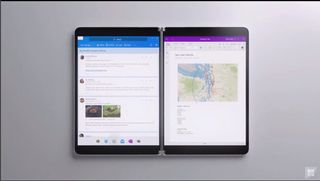
Windows 10X might have been conceived as an operating system for dual-screen devices, but it’ll be arriving on traditional single-screen laptops first, Microsoft has confirmed – raising fresh questions and concerns about exactly how the OS might pan out, and whether it could initially disappoint.
As you may be aware, this information bears out a previous rumor from the reliable Mary Jo Foley, indicating that Microsoft’s chief product officer, Panos Panay, had said that Surface Neo wouldn’t be launching this year as planned (but Surface Duo would – on Android of course), and no other third-party dual-screen devices would be shipping with Windows 10X either.
- Windows 10: how good it is really these days?
- Microsoft Surface Neo: all the latest news and rumors
- How to work smarter from home with Windows 10
In a blog post on ‘accelerating innovation in Windows 10’, Panay observed that Windows 10X was designed around flexibility – not dual-screen devices as such, although they are obviously made to be more versatile – and that this flexibility “has enabled us to pivot our focus toward single-screen Windows 10X devices that leverage the power of the cloud to help our customers work, learn and play in new ways.”
Panay says: “These single-screen devices will be the first expression of Windows 10X that we deliver to our customers, and we will continue to look for the right moment, in conjunction with our OEM partners, to bring dual-screen devices to market.”
Whatever that right moment will be is obviously anyone’s guess, but slightly earlier in the post, Panay mentions that “this holiday and the next” Microsoft is going to “accelerate innovation in Windows 10 to ensure that Windows devices are the best way to work, learn and play.”
That’s not a hint that we could be looking at a holiday 2021 launch – the next holiday season – for Surface Neo, is it? You would certainly hope that a delay of an entire year wouldn’t be in the cards, but certainly the language Microsoft is using doesn’t sound particularly promising for those who are keen to see dual-screen devices pitch up sooner rather than later.
Reasons for delay
As we’ve discussed before, the delay is doubtless tied up with the coronavirus outbreak, and although it’s not mentioned specifically, Panay references at several points how the world’s changing, and how it’s a very different place now – and indeed how people’s routines are changing, and the way they work.
Indeed, it’ll doubtless be no surprise to hear that Windows 10 users are spending a lot more time on their PCs: in excess of 4 trillion minutes per month, according to the latest figures, which is 75% more than the same time last year.
As to exactly how coronavirus may have affected Microsoft’s intended schedule with Surface Neo (and the launch of other dual-screen devices), it could be a number of factors including manufacturing delays on the hardware side, and perhaps disruption to the way Microsoft itself works.
Other considerations to mull over are launching more expensive devices into a potentially wonky economic climate, or uncertainty around the possibility of there being more of a general wholesale shift towards a working from home model, and how much that might affect the need for portable productivity devices (that said, Surface Duo is, at least according to reports, still on track – although maybe that speculation is incorrect).
In all likelihood, there’s probably a mix of considerations, which when combined with general uncertainty around how the world will be going forward, has persuaded Microsoft to play it safe rather than attempt a big launch.
The question then remains: what exactly will Windows 10X do for traditional single-screen portables? That’s unclear, seeing as the initial line with the OS was very much that it’s made for dual-screen hardware. And the danger is if these traditional notebooks running the new operating system are disappointing, this could taint the public perception of Microsoft’s latest spin on its desktop OS.
The original plan for Microsoft, at least according to leaked documents which surfaced online back in October 2019, was to launch Windows 10X on dual-screen devices at the end of 2020, with traditional clamshell laptops following..
source: techradar

